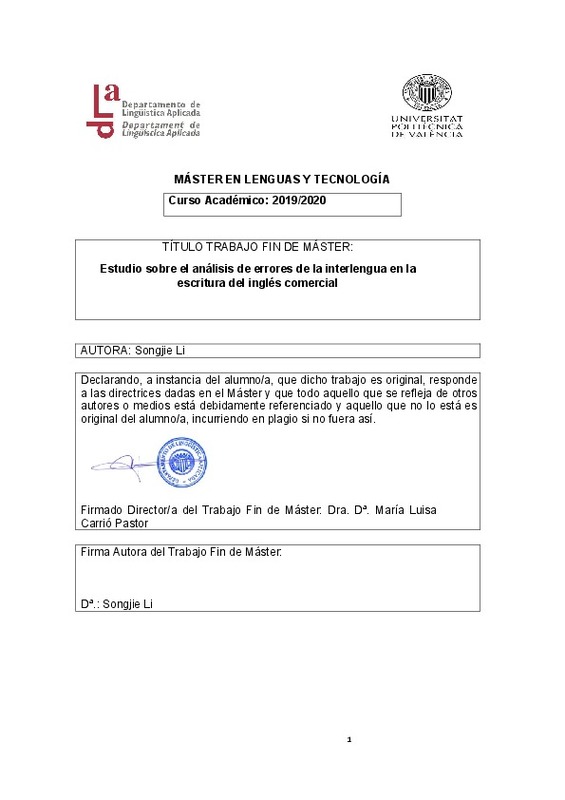|
Resumen:
|
[ES] La interlengua es un sistema del lenguaje único producido por alumnos que
aprenden una segunda lengua en el proceso de aprendizaje de la lengua meta. Este sistema del lenguaje se encuentra estructuralmente en un ...[+]
[ES] La interlengua es un sistema del lenguaje único producido por alumnos que
aprenden una segunda lengua en el proceso de aprendizaje de la lengua meta. Este sistema del lenguaje se encuentra estructuralmente en un estado
intermedio entre el idioma nativo y la lengua meta. La interlengua constituye así
un sistema del lenguaje en continuo desarrollo donde cada alumno está en un
cierto punto de desarrollo del proceso de la interlengua. Con el desarrollo del
aprendizaje, el nivel del idioma de los alumnos se acerca gradualmente a la
lengua meta. Consecuentemente, y debido a las inevitables diferencias entre el
idioma aprendido y el idioma nativo, los alumnos cometen los errores durante el
proceso de aprendizaje del segundo idioma. Cualquier alumno de idiomas debe
pasar por el proceso de aprendizaje de crear la interlengua, desarrollándola y
corrigiendo los errores. En consecuencia, la teoría del análisis de errores
basada en la interlengua requiere que los profesores de idiomas extranjeros
analicen los errores en el lenguaje de los alumnos durante el proceso de
aprendizaje de la segunda lengua. Al mismo tiempo, los profesores deben
observar y analizar los errores en la interlengua y comprender las
características de las etapas de desarrollo en el ámbito del aprendizaje, para
poder enseñar de acuerdo con los conocimientos lingüísticos de los alumnos. La teoría del análisis de errores es una rama de la lingüística aplicada que
comenzó en la década de 1960 y se desarrolló completamente en la década de
1970. El análisis de errores consiste en un análisis exhaustivo y sistemático de
los errores cometidos por los alumnos en el proceso de aprender idiomas
extranjeros, con el fin de explorar y estudiar la naturaleza y las causas de los
errores, evitando o, en su defecto, reduciendo esos errores. Los errores forman
parte del proceso de aprendizaje y juegan un papel muy importante en la
enseñanza de lenguas extranjeras. Como consecuencia de las investigaciones centradas en este ámbito en China
y en otros países, muchos académicos han realizado estudios sobre la enseñanza de lenguas extranjeras basándose en la teoría del análisis de
errores de la interlengua, centrándose muchos de estos estudios únicamente
en la enseñanza del inglés general, por lo que pocos académicos han
analizado específicamente la enseñanza del inglés comercial desde el punto de
vista de la interlengua. Por lo tanto, este estudio describe los conceptos y las
investigaciones relacionadas con la interlengua y el análisis de errores, analizando los errores de la escritura en inglés comercial por parte de alumnos
cuya lengua nativa es el chino. El estudio combina la investigación cualitativa y
cuantitativa para clasificar y analizar varios errores en la escritura del inglés
comercial, como los errores léxicos, sintácticos y del discurso con el fin de
proporcionar algunas sugerencias pragmáticas para los profesores y los
alumnos de escritura del inglés comercial, pretendiendo con ello mejorar la
enseñanza del mismo en las universidades chinas.
[-]
[EN] Interlanguage is a unique language system produced by second language
learners in the target language learning process. This language system is
structurally in an intermediate state between the native language and ...[+]
[EN] Interlanguage is a unique language system produced by second language
learners in the target language learning process. This language system is
structurally in an intermediate state between the native language and the target
language. The interlanguage thus constitutes a language system in continuous
development where each student is at a certain point of development of the
interlanguage system. With the development of learning, the language level of
the students gradually approaches the target language. Consequently, and due
to the inevitable differences between the target language and the native
language, students make mistakes during the second language learning
process. Any language learner must go through the learning process of creating
interlanguages, developing them and correcting errors. Consequently, the
interlanguage-based theory of error analysis requires foreign language teachers
to analyze students' language errors during the second language learning
process. At the same time, teachers must observe and analyze inter-language
errors and understand the characteristic stages of development in the interlanguage field in order to teach according to the students' basic English ability. Error analysis theory is a branch of applied linguistics that began in the 1960s
and was fully developed in the 1970s. Error analysis is a comprehensive and
systematic analysis of errors made by students in the process to learn foreign
languages, in order to explore and study the nature and causes of language
errors, avoiding or failing to reduce language errors. Mistakes are a process of
learning progress and play a very important role in teaching foreign languages. Throughout the research focused on this field in China and other countries, many scholars have done a lot of research on the teaching of foreign languages
based on the theory of interlanguage error analysis, many of these studies
focusing only on the teaching of English, so few academics have set their sights
on teaching business English. Therefore, this study describes the concepts and
related research of interlanguage and error analysis, analyzing errors in business English writing by business English learners in a native Chinese
environment. The study combines qualitative and quantitative research to
classify and analyze various errors in business English writing, such as lexical, syntactic, and speech errors, to provide some pragmatic suggestions for
business English writing teachers and students, improving the teaching of it in
Chinese universities.
[-]
|







